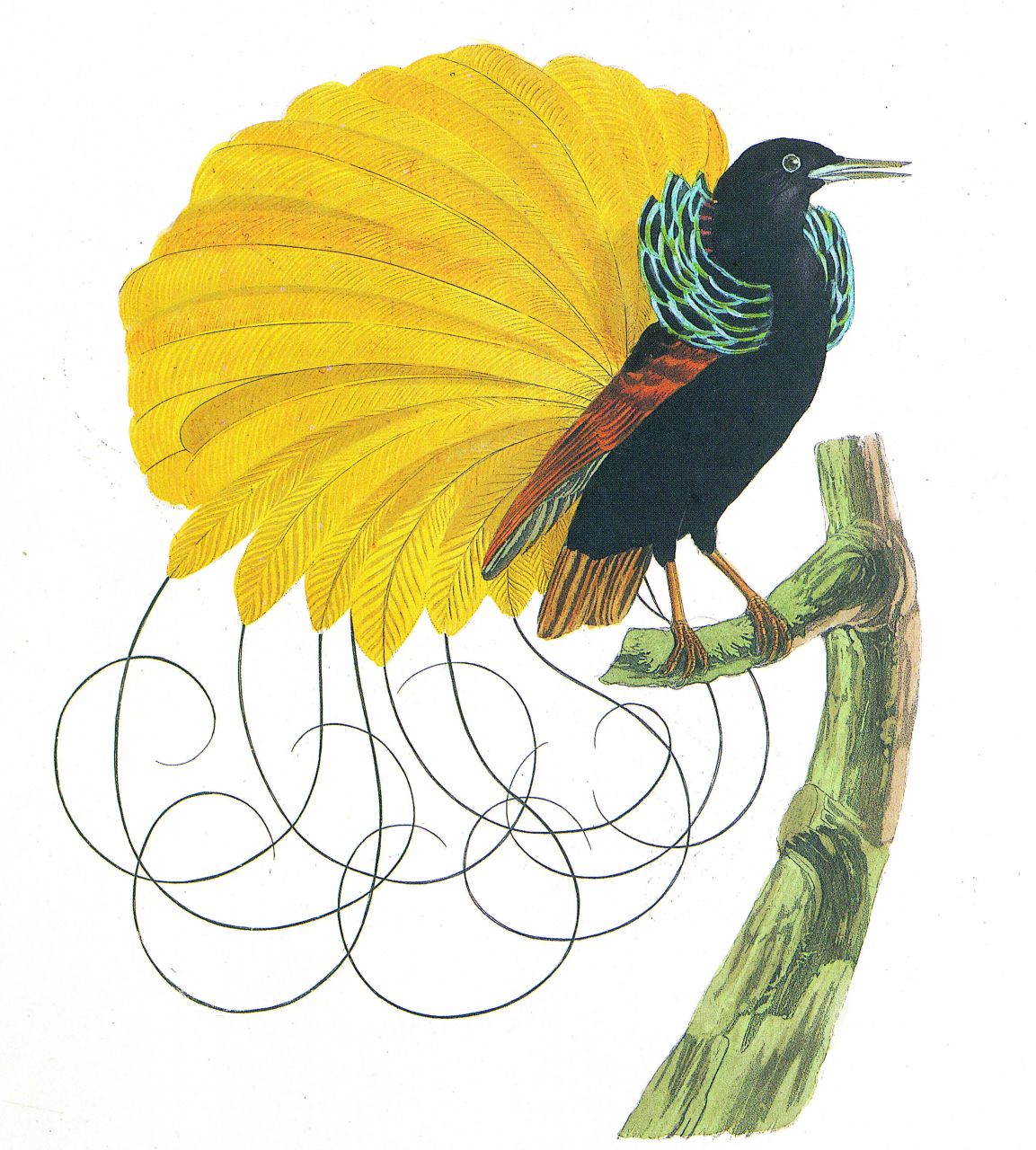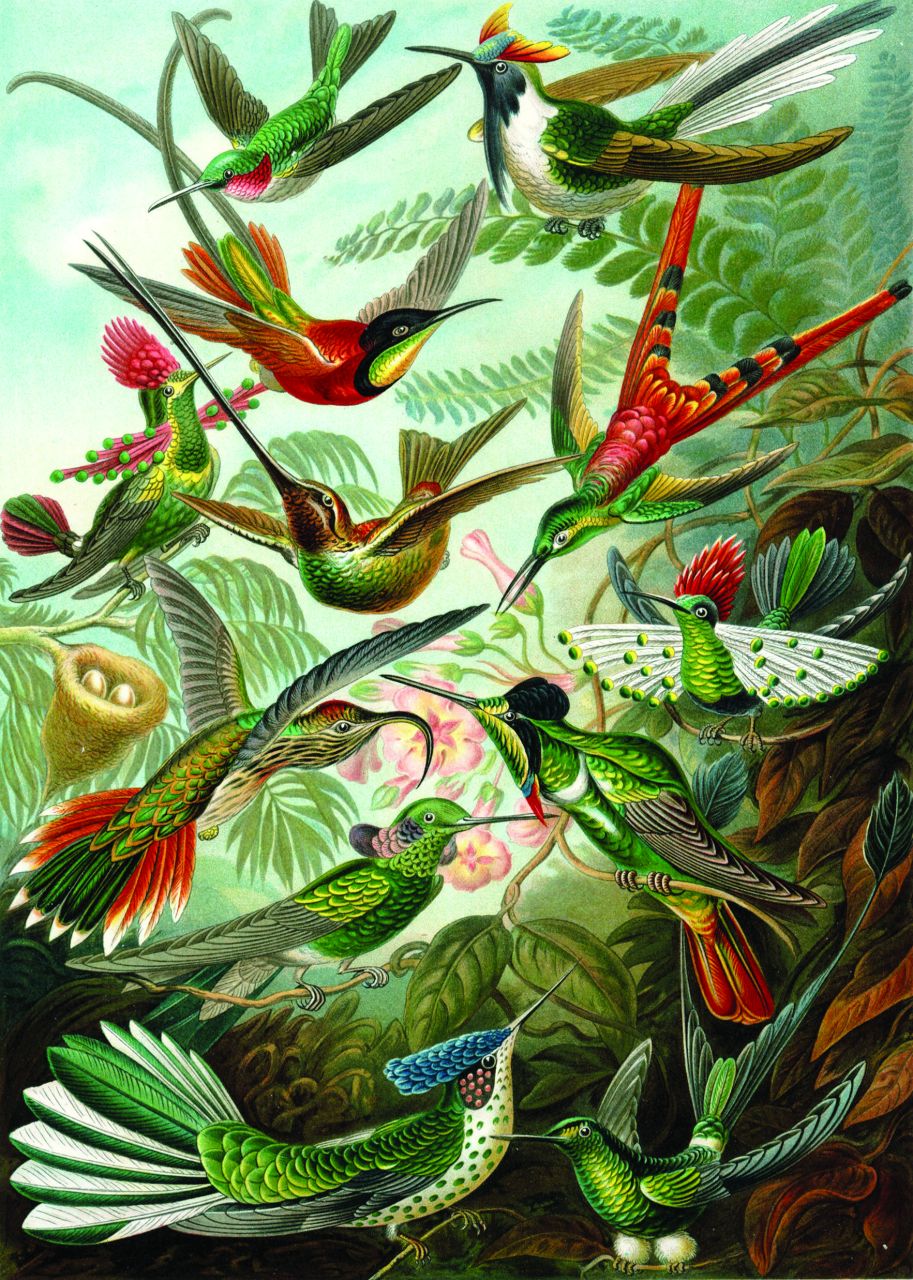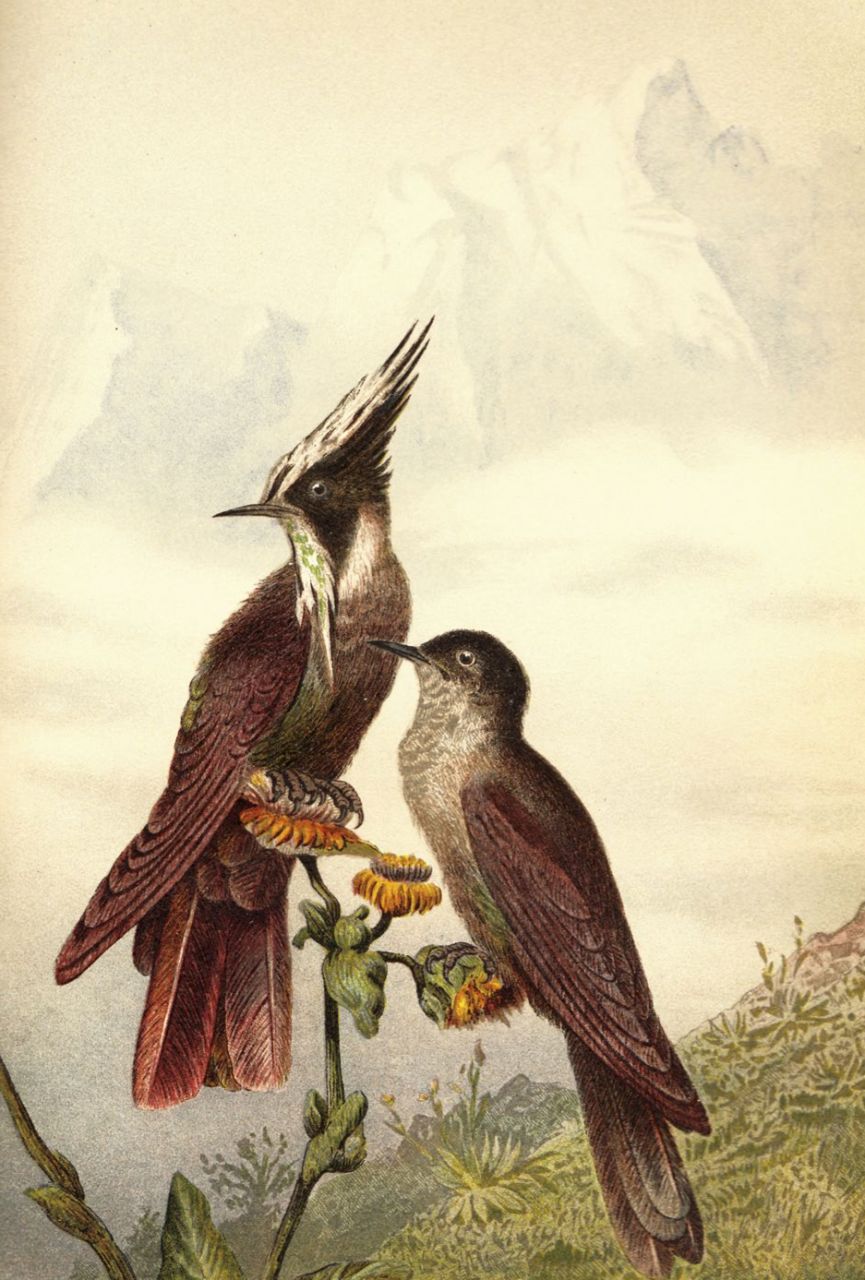
Le Nebuleux Bird of Paradise. Robert Havell, 1835.
Editor’s note: The following is an excerpt from “Birdmania: A Remarkable Passion for Birds” by Bernd Brunner. The book explores humanity’s fascination with birds, showcasing an eclectic and fascinating selection of devotees who would do anything for their feathered friends.
When the first birds of paradise arrived with Ferdinand Magellan’s ship Victoria in Seville harbor on September 8, 1522, along with a priceless cargo of spices, they looked nothing like their living counterparts. The specimens did not come close to conveying the living birds’ fascinating splendor. They were gossamer-light, dried skins wrapped around a stick. Nothing remained but long silky feathers, glossy and shimmering with color. Antonio Pigafetta (1491–1534), who traveled on another of the ships in Magellan’s fleet to document the journey around the world, wrote:
These birds are as large as thrushes; they have small heads, long beaks, legs slender like a writing pen, and a span in length; they have no wings, but instead of them long feathers of different colours, like plumes: their tail is like that of the thrush. All the feathers, except those of the wings, are of a dark colour; they never fly, except when the wind blows. They told us that these birds come from the terrestrial Paradise, and they call them “bolon dinata” that is divine birds.
Juan Sebastián Elcano, the captain of the Victoria, received the first specimens from the sultan of Bacan as a gift. When the natural historian Francisco López de Gómara examined them, he declared, “We are of the opinion that these birds are nourished by dew and the nectar of spice trees. Whether that is true or not, one thing is certain, they never decay.”
The birds were said to come from islands in the vicinity of terra australis incognita (the unknown land of the south). Their provenance was only the beginning of a legend that would continue to grow over the centuries and came close to causing strife between the colonial powers of the day. Probably it was the incompleteness and mysteriousness of the birds’ remains that gave rise to their distinctive mystique. They were exotic treasures and objects of desire.
What no one wanted to believe, even though Pigafetta had hinted at the practice, was that while preserving the skins, the islanders removed not only the flesh and bones but also the feet and sometimes even the wings. The skins’ amazed recipients took that as proof that the birds never touched the ground but spent their lives floating on the breeze, and that they therefore deserved to be classified in their own separate order. Following this line of reasoning, one Bishop Simolus wrote in 1597:
As long as they live, they live the lives of angels, but when they die, they fall from the sky like the Devil, never to return. And so they are a symbol for sinners who, suddenly cast from God’s grace, tumble down into Hell.
Carolus Clusius (1526–1609) was a naturalist who worked at the court of the Holy Roman Emperor Rudolf II of the House of Habsburg and then, starting in 1593, as a professor at the University of Leiden. He is credited with naming new species, including the greater bird of paradise and the king bird of paradise. Even though he, too, had never seen a live bird of paradise, he saw through the taxidermists’ mutilations, but nobody wanted to listen to him because that would have disturbed not only the birds’ mystical aura but also commercial interests and relationships. And so the mystique of the divine birds continued for quite some time. Two esteemed ornithologists, Carl Linnaeus (1707–78) and George-Louis Leclerc de Buffon (1707–88), were among those who fell for the fairytale. Linnaeus even came up with a name for them: Paradisea apoda or “footless bird of paradise.”
Depictions of the birds in contemporary sketches and watercolors were also far from realistic, as belief in the birds’ miraculous qualities was too strong for obvious but mundane facts to prevail, and artists were handicapped because they could not observe live birds in their natural surroundings. In his book Ornithologiae, Aldrovandi depicted the bird without legs and even surmised that the two long tail feathers served in lieu of feet. It was not until the middle of the seventeenth century that it was finally demonstrated that the birds did, indeed, have legs, feet, and wings.
A French ship’s surgeon named René Primevère Lesson (1794–1849) started out on the trail of birds, butterflies, and plants in his youth, and when he arrived in New Guinea in 1823–24, he wrote enthusiastically:
We were walking carefully following paths made by wild pigs in the shady depths of the thick forest around the port of Doréy, when a tiny emerald-green bird of paradise flew over our heads with airy swoops, graceful and agile. To us it seemed like a meteor, its fiery tail splitting the air with a long trail of light.
Lesson must have been one of the very first Western naturalists to see a live specimen of this bird. He published the results of his research in 1835 under the title Histoire naturelle des oiseaux de paradis (The Natural History of Birds of Paradise). These rare and seemingly mysterious creatures could put bird hunters into a state of high excitement until well into the second half of the nineteenth century. In 1872, the Italian naturalist Luigi d’Albertis (1841–1901) traveled around New Guinea. Plagued by dropsy, he dragged himself through the jungle on painfully swollen legs and feet, but he forgot all about his discomfort the moment he set eyes on a bird of paradise: “My excitement was so great that when I saw it fall I ran to secure it, forgetting the state of my legs, though a moment before I had hardly been able to drag them along.”
The days when gorgeous bird of paradise feathers decorated hats in fashionable circles are now long gone, but the residents of Papua New Guinea have used the birds’ plumage to decorate elaborate headdresses worn on ceremonial occasions, primarily by men, since time immemorial and continue to do so. In addition, feathers and skins were traditionally valued as trade items. Laws today try to balance respect for cultural practices with the urgent need for conservation of these beautiful birds with their spectacular, showy plumes.
Ornithologists are still on the trail of birds of paradise in the jungles of Papua New Guinea; however, their goals are completely different from those of bird hunters a couple of centuries ago. Jack Dumbacher, the curator of the California Academy of Sciences, is one of these ornithologists. His specialties are the ecology and evolution of birds of paradise and tropical diseases in this part of the world. He says that working in New Guinea is like going back in time. Incidentally, Dumbacher made a splash in ornithological circles when he discovered that the poison homobatrachotoxin can be found hiding in the skin and feathers of the orange-and-black hooded pitohui, a kind of oriole. This pitohui is one of the few poisonous birds in the world, as Dumbacher discovered when he accidently trapped one in a net set for birds of paradise and the pitohui scratched him as he removed it. As he was sucking the wound, he realized that his mouth had gone numb. At first, he thought nothing of it. It was only a year later, when he absentmindedly put one of the bird’s feathers into his mouth and immediately noticed its extremely unpleasant taste, that he thought to research the subject further. Homobatrachotoxin is more toxic than strychnine and comes from a particular kind of beetle the pitohui eats.

Hummingbirds. Ernst Haeckel 1899-1904.
The conquerors of the New World hunted other airborne treasures. Some—minuscule winged jewels that buzzed around their heads in tiny clouds—were particularly perplexing. Were these creatures insects or birds? The French called them oiseaux mouches (bird flies), the Portuguese beija-flores (flower kissers) or chupa-flores (flower suckers), the Spanish picaflores (flower stingers). The English called them humbirds from about 1640 and later changed their name to hummingbird. Very tiny species in Brazil were also called besourinhos (little beetles), and the Cubans gave the bee hummingbird the enchanting name zunzuncito. The German name, Kolibri—also used in Spanish today (colibrí)—is likely Caribbean in origin. In 1758, Carl Linnaeus, who knew 18 of the 340 species known today, gave it the scientific name Trochilus.
The first mention of this frenetically active little bird can be found in the travel journals of Jean de Léry (1536–1613), who belonged to a crew of mariners sent to the Brazilian coast. In his journal, published in 1557, he mentioned a bird whose body was “no larger than that of a hornet or a stag beetle.” He called it “an extraordinary wonder and a masterpiece of minuteness.” Georg Markgraf (1610–48), who traveled to Brazil in 1638, wrote in his book Historia naturalis Brasiliae (A Natural History of Brazil), published in 1648, that the ruby throated hummingbird, weighing in at slightly over one-tenth of an ounce (barely 4 grams), was the most beautiful of all the hummingbirds, and he had seen many on his travels.
Acrobats of the air, hummingbirds can quickly make themselves scarce when danger threatens. But they can also be fearless, as many observers have noted with some amazement.
See it darting through the air almost as quick as thought!—now it is within a yard of your face!—in an instant gone!—now it flutters from flower to flower to sip the silver dew—it is now a ruby—now a topaz—now an emerald—now all burnished gold!
So wrote the English naturalist Charles Waterton (1782–1865) after traveling through Latin America in the early nineteenth century.
After birds of paradise, hummingbirds were among the highlights of eighteenth- and nineteenth-century natural history collections. In many parts of the world, bird catchers sold their hastily preserved plunder to natural history museums and bird lovers. In Victorian drawing rooms, they served the same purpose as decorative flowers—and often ended up as dust collectors.
After traveling to South America and other lands on the corvette La Coquille, Lesson described nearly forty new species and produced a multivolume monograph with 261 wonderfully detailed and hand-colored lithographs. The English naturalist Philip Henry Gosse (1810–88)—perhaps best known for popularizing the home aquarium—made detailed observations of hummingbirds in Jamaica and relied on Lesson’s work to identify them. He also took it upon himself to denounce the widely held misconception that hummingbirds could be dangerous to people. He wrote in The Birds of Jamaica that “the spirit of curiosity is manifested by this little bird… stories of Humming-birds attacking men, and striking at the eyes with their needle-like bills, originated, I have no doubt, in the exaggeration of fear, misinterpreting this innocent curiosity.”
It is no accident that you almost only see hummingbirds in flight, for, more than any other land-based bird, they have freed themselves from the shackles of the Earth. They cannot even walk.

Helmetcrest Hummingbirds. Alfred E. Brehm, 1891.
Hummingbirds are primarily (although not exclusively) nectar feeders, and the reciprocal affinity between hummingbirds and flowers was long described as “love,” because people did not understand the concept of a close symbiotic relationship and had no idea that birds and plants could evolve together. Many species of birds visit flowers, but none is as exquisitely adapted for the task as hummingbirds. Not only because the length and curve of their beaks fit the forms of the flowers they visit (sunbirds, for example, share this characteristic), but also because of the unique way they approach flowers. Whereas most birds need to perch next to blooms, this is not the case for most hummingbirds. You could say they “stand” suspended in the air in front of flowers while feeding. Gosse did notice, however, that streamertails (a species of hummingbird found in Jamaica) are not always airborne when they feed.
They do not invariably probe flowers upon the wing; one may frequently observe them thus engaged, when alighted and sitting with closed wings, and often they partially sustain themselves by clinging with the feet to a leaf while sucking, the wings being expanded, and vibrating.
And, it should be added, hummingbirds, like insects, also pollinate flowers while they are snacking on nectar.
By the middle of the seventeenth century, people knew that hummingbirds drank nectar, and a couple of decades later they observed that they ate insects as well, for they need not only carbohydrates but also protein and fat to survive. However, it took a very long time for this to become common knowledge, partly because it contradicted the much-loved romantic notion that these wonderful birds sustained themselves on nothing but drops of dew, air, and love. You could fill a whole book with descriptions of experiments in hummingbird nutrition. In 1837, the German biologist Lorenz Oken (1779–1851) knew that they could survive no more than a couple of months on “sweet plant juices” alone but as long as a year “if they are free to fly in a room with only canvas covering the windows so flies can get in.” Many different people tried hard to introduce hummingbirds to Europe, but it soon became clear that they could not survive there—and most did not even survive the journey over.
It can be exhausting to watch hummingbirds darting about. How is it possible to understand a creature whose movements are so fast that we cannot observe them with the senses Nature gave us? Toward the end of the nineteenth century, observers could capture the flight of other birds on film and break the sequence down into individual frames. The high frequency of the hummingbird’s wing beat (which, as we now know, is from 12 to 80 strokes per second depending on the species) called for other methods. In 1928,
MIT professor Harold E. Edgerton (1903–90)—who would later shoot the famous photograph of the impact of a single drop landing in a bowl of milk—combined a strobe light with a film camera in a friend’s garden to film hummingbirds comfortable around people. He was soon able to film at a rate of 540 frames per second. Edgerton provided proof that hummingbirds beat their wings horizontally and can fly backwards. He also discovered that when they hover, they rotate their wings, and as they power them backward, they displace air. You could compare how they move their wings to how swimmers move their arms when they are doing the backstroke. Nature’s wonders indeed.
—
Excerpted from Birdmania: A Remarkable Passion for Birds, by Bernd Brunner ©. Translation by Jane Billinghurst. Published in 2017 by Greystone Books. Reprinted with permission of the publisher.
